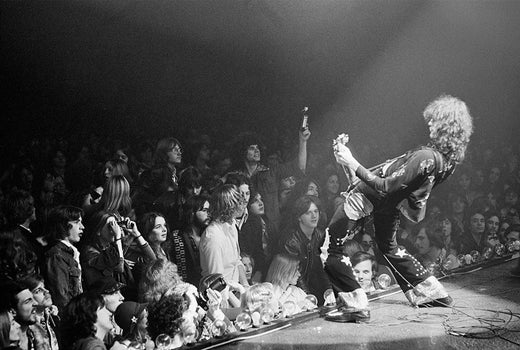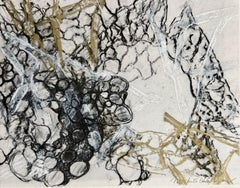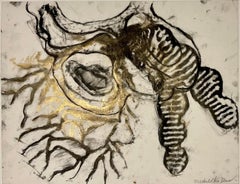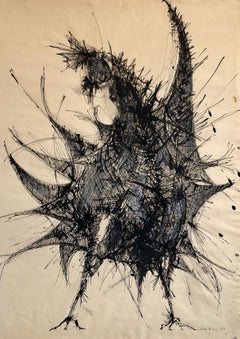Want more images or videos?
Request additional images or videos from the seller
1 of 7
Michael BrennanUntitled, (8)1997
1997
$1,000List Price
About the Item
- Creator:Michael Brennan (1965, British)
- Creation Year:1997
- Dimensions:Height: 17.5 in (44.45 cm)Width: 15.25 in (38.74 cm)
- Medium:
- Movement & Style:
- Period:
- Condition:Measurements include frame.
- Gallery Location:Surfside, FL
- Reference Number:1stDibs: LU3821970213
Michael Brennan
Award-winning photographer Michael Brennan’s work covers a wide range of historical events, celebrity portraits, candid’s and world famous athletes. After winning the British News Picture of the Year for his coverage of the death of Donald Campbell in 1967, which was featured in Life magazine, he went on to work for several newspapers and covered important news events as well as capturing images of notable names. He was awarded British Photographer of the Year in 1969. His archive includes images of Led Zeppelin, Freddie Mercury, Mick Jagger, President Jimmy Carter, Princess Diana, John Lennon, and sport legends George Best, Pele, George Foreman, Mike Tyson and Muhammad Ali. His work has been featured in newspapers and magazines world-wide, including Sports Illustrated, Life, Rolling Stone, Stern, The New York Times, The Sunday Times, The Observer, and the Times of London. One of his most iconic portraits of Muhammad Ali is in the collection of the Smithsonian’s National Portrait Gallery.
About the Seller
4.9
Platinum Seller
Premium sellers with a 4.7+ rating and 24-hour response times
Established in 1995
1stDibs seller since 2014
1,823 sales on 1stDibs
Typical response time: 1 hour
Authenticity Guarantee
In the unlikely event there’s an issue with an item’s authenticity, contact us within 1 year for a full refund. DetailsMoney-Back Guarantee
If your item is not as described, is damaged in transit, or does not arrive, contact us within 7 days for a full refund. Details24-Hour Cancellation
You have a 24-hour grace period in which to reconsider your purchase, with no questions asked.Vetted Professional Sellers
Our world-class sellers must adhere to strict standards for service and quality, maintaining the integrity of our listings.Price-Match Guarantee
If you find that a seller listed the same item for a lower price elsewhere, we’ll match it.Trusted Global Delivery
Our best-in-class carrier network provides specialized shipping options worldwide, including custom delivery.You May Also Like
Gala Barbisan, India ink on paper, "Surrealist Drawing," Italy, 1967
Located in Vicenza, VI
Gala Barbisan, birth name Galina Nicolaeva Solovieva, was born in Russia in 1904 and moved to Italy in 1935. His artistic activity began in the 1960s and he mainly made drawings in t...
Category
1960s Abstract Abstract Drawings and Watercolors
Materials
Paper, India Ink
$592
H 12.21 in W 18.12 in D 0.04 in
Purple & Yellow Modern Urban Abstract
By Carl E. Schwartz
Located in Soquel, CA
Modern and bright urban abstract in yellow & purple by Carl E. Schwartz (American, 1935-2014), c.1970s. Signed "Schwartz" lower right. Presented in a silver metal frame. Image size: ...
Category
1970s Abstract Expressionist Abstract Drawings and Watercolors
Materials
Paper, Ink, Watercolor
$920 Sale Price
20% Off
H 20 in W 24 in D 1 in
Bobine
By Alexander Calder
Located in Palm Desert, CA
"Bobine" is a gouache and ink on paper by Alexander Calder. The work is signed in the lower right "Calder 72".
A12922
Although renowned for his innovative and groundbreaking sculptures, Alexander Calder started his artistic career as an abstract painter, preferring to use gouache. What is gouache? Gouache is a water-soluble paint – a type of opaque watercolor.
As Calder returned to gouache painting towards the end of his life, he was now armed with a lifetime of experience as a sculptor. He explored the three-dimensional vocabulary of sculptural forms he had developed onto the two-dimensional surface of the paper. Certain shapes and colors recur throughout his gouaches and sculptures. Circles, ovals, and other geometric forms dominate the space. There is the same sense of energy and fluidity. The shapes do not sit on the surface but vibrate giving a feeling of movement in contrast to the static nature of painting.
Like his sculpture, Calder’s gouache...
Category
1970s Abstract Abstract Drawings and Watercolors
Materials
Paper, Ink, Gouache
Metamorphosis II - abstract painting, made in black, grey color, ink
By Mila Akopova
Located in Fort Lee, NJ
Interior design paintings. The work was done with india ink in black and grey color on Yupo paper. The work is 11 by 14 inches in size, framed 16 by 20 inches.
Mila Akopova is New ...
Category
2010s Abstract Abstract Drawings and Watercolors
Materials
Paper, India Ink
300K, 100 OBVERSE LEFT AND RIGHT "WATERMELON NOTE". Diptych. Drawing on paper
By Rodrigo Spinel
Located in Miami Beach, FL
As a reflection on the value we give to objects, this series exposes examples of objects that we use daily and for different reasons ended up gaining very high prices. By redrawing t...
Category
2010s Abstract Abstract Drawings and Watercolors
Materials
Paper, India Ink
$3,000
H 16.93 in W 22.05 in D 1.58 in
Fig. 8. From The Dibujar el Tiempo Series
By Rodrigo Spinel
Located in Miami Beach, FL
The project is a series of ink drawings on different surfaces, depicting the solstices and equinoxes of the year through the overlapping of shadows at various times of the day. ...
Category
2010s Abstract Abstract Drawings and Watercolors
Materials
Paper, India Ink
Fig. 8 BASE MORADO and NEUTRO, Diptych. From The Dibujar el Tiempo Series
By Rodrigo Spinel
Located in Miami Beach, FL
The project is a series of ink drawings on different surfaces, depicting the solstices and equinoxes of the year through the overlapping of shadows at various times of the day. ...
Category
2010s Abstract Abstract Drawings and Watercolors
Materials
Paper, India Ink
$1,800
H 23 in W 33.78 in D 1.19 in
Fig. 9 BASE. From The Dibujar el Tiempo Series
By Rodrigo Spinel
Located in Miami Beach, FL
The project is a series of ink drawings on different surfaces, depicting the solstices and equinoxes of the year through the overlapping of shadows at various times of the day. These...
Category
2010s Abstract Abstract Drawings and Watercolors
Materials
Paper, India Ink
$1,100
H 28.9 in W 22.88 in D 1.19 in
Fig. 8 BASE VERDE and NARANJA, Diptych. From The Dibujar el Tiempo Series
By Rodrigo Spinel
Located in Miami Beach, FL
The project is a series of ink drawings on different surfaces, depicting the solstices and equinoxes of the year through the overlapping of shadows at various times of the day. These...
Category
2010s Abstract Abstract Drawings and Watercolors
Materials
Paper, India Ink
$1,800
H 23 in W 33.78 in D 1.19 in
Grass Power, original unique signed drawing, hand signed and inscribed; Framed
By Mark di Suvero
Located in New York, NY
Mark di Suvero
Grass Power, 1979-2014
Mixed Media drawing: marker, ink and pencil on paper
Hand titled, signed and inscribed to Nadine by Mark di Suvero
Frame included:
Floated and f...
Category
2010s Abstract Expressionist Abstract Drawings and Watercolors
Materials
Paper, Ink, Permanent Marker, Pencil, Mixed Media
$7,500
H 17.5 in W 20.5 in D 2 in
More From This Seller
View AllOriginal Drawing Painting Abstract Biomorphic Art Gold Leaf Michele Oka Doner
By Michele Oka Doner
Located in Surfside, FL
This is mixed media. I am not positive of the materials. it is a translucent, vellum, parchment type of paper. with either charcoal or ink and gold leaf (or gold paint) hand signed i...
Category
Early 2000s Abstract Abstract Drawings and Watercolors
Materials
Paper, Charcoal, Ink, Pencil
Original Drawing Painting Abstract Biomorphic Art Gold Leaf Michele Oka Doner
By Michele Oka Doner
Located in Surfside, FL
This is mixed media. I am not positive of the materials. it is a translucent, vellum, parchment type of paper. with either charcoal or ink and gold leaf (or gold paint) hand signed in pencil lower right.
It is not titled on it.
Michele Oka Doner (born 1945, Miami Beach, Florida, United States) is an American artist and author who works in a variety of media including sculpture, lithograph and woodcut prints, drawing, watercolor painting, functional objects and video. Her workes is based on flora, fauna, DNA and all sorts of exotica. She has also worked in costume and set design and has created over 40 public and private permanent art installations, including her best known artwork is "A Walk on the Beach" (1995, 1999), and its extension, "A Walk on the Beach: Tropical Gardens" (1996–2010) at the Miami International Airport. It is composed of over 9000 bronzes embedded in terrazzo with mother-of-pearl. At one and quarter linear miles, it is one of the largest artworks in the world.
Born and raised in Miami Beach, Oka Doner is the granddaughter of painter Samuel Heller. Oka Doner's father, Kenneth Oka, was elected judge and mayor of Miami Beach during her youth (1945–1964). The family lived a public and politically active life. In later years, Oka Doner co-authored, with Mitchell Wolfson Jr. Miami Beach: Blueprint of an Eden, an intimate portrayal of Miami Beach from the 1920s to the 1960s using their families as prisms to reflect the times. Reviewed as classic of social history, with material that was part of the public record of its time, it was used as a textbook in Human Geography at George Washington University in 2008.
In 1957, age 12, Oka Doner began a year-long independent project studying the International Geophysical Year (IGY). She assembled a book of drawings, writings and collages that became a template for projects realized in later years. In 1963, Oka Doner left Florida for the University of Michigan, Ann Arbor. Her art instructor Milton Cohen...
Category
Early 2000s Abstract Abstract Drawings and Watercolors
Materials
Gold Leaf
Untitled, (6)
By Michael Brennan
Located in Surfside, FL
Michael Brennan (b.1965, Pine Island, FL; lives Brooklyn, NY) has exhibited his work nationally and internationally for the past two decades, including in the United States, Mexico, Belgium, Germany, Australia, and New Zealand. His paintings and works on paper have been reviewed in publications, including The New York Times, Art in America, ARTnews, Art New England, The Brooklyn Rail, ArtNet Magazine, and NY Arts. His writings and reviews have been published by The Brooklyn Rail, ArtNet Magazine, The Village Voice, The Architect’s Newspaper, American Abstract Artists, and Archives of American Art/Smithsonian Institution, among others.
Brennan’s work is included in collections, such as the Baltimore Museum of Art, National Gallery of Art, San Francisco Museum of Modern Art, San Jose Museum of Art, American Express, General Dynamics, Daimler AG, and Sony Corporation. Brennan holds an MFA from Pratt Institute, Brooklyn, NY, and a BA from the University of Florida. He is currently Adjunct Assistant Professor at Pratt Institute and has also taught at the School of Visual Arts, Hunter College, and Cooper Union in NYC.
GALLERY EXHIBITIONS
Brant / Brennan / Zinsser, June 4 – July 2, 2016
Michael Brennan: Grey Razor Paintings, January 10 – February 15, 2014
Escape from New York...
Category
Late 20th Century Abstract Abstract Drawings and Watercolors
Materials
Paper, Ink
Large Ink Drawing Abstract Expressionist Rooster Woman Artist Judith Brown
By Judith Brown
Located in Surfside, FL
Judith Brown (December 17, 1931 – May 11, 1992) was a dancer and a sculptor who was drawn to images of the body in motion and its effect on the cloth surrounding it. She welded crushed automobile scrap metal into energetic moving torsos, horses, and flying draperies.
Brown attended Sarah Lawrence College in Yonkers, New York (B.A., 1954), where she learned to weld from her teacher, Theodore Roszak, a pioneering abstract expressionist sculptor. This is done in a style similar to Leonard Baskin.
Select Commissions
Mural Sculpture, Lobby, Louisville Radio Station WAVE
Fountain, commissioned by Architectural Interiors, New York City
Model, designed and executed for Festival of Two Worlds, Spoleto, Italy
Sculpture, designed for Electra Film Productions, NYC
Noah's Ark, exhibited at Bronx Zoo, New York City, at Rochester Museum and Science Center, Rochester, New York, and at Hopkins Center, Hanover, New Hampshire
Store Windows, executed Tiffany & Company Windows, New York City, Christmas 1957, 1959, 1962, October 1969, Spring 1979, and October 1980
Wall Sculptures: for Youngstown Research Center (1963-4), commissioned by Youngstown Steel Company, Youngstown, Ohio; for Hecht and Company, Landmark Shopping Center, Alexandria, Virginia, Daniel Schwartzman, Architect; for Lobby, 570 Seventh Avenue, New York City, Giorgio Cavaglieri, Architect; for Lobby, Cities Service Company's New Research Center, Cranbury, New Jersey; for Ottauquechee Health Center, Woodstock, Vermont
Eternal Lights: for Congregation Beth-El, South Orange, New Jersey; for Congregation Sharey Tefilo, East Orange, New Jersey
Menorahs: commissioned by Architect Fritz Nathan for the Permanent Collection of the Jewish Museum, New York City; commissioned by Smith College for the Helen Hill Chapel, Northampton, Massachusetts; commissioned by Jules Scherman, of Wisteria Press, Inc., New York City
Altar Cross, commissioned by Smith College for the Helen Hill Chapel, Northampton, Massachusetts
Landscape, Memorial Piece for Gustave Heller, YM-YWCA, Essex County, New Jersey
Memorial Plaque for Robert A. Ferguson, Westchester County Airport, Purchase, New York
Sculpture for Vice President's office, Atlantic Richfield Company, New York City
Bronze Relief Sculpture for Gymnasium Lobby, South Richmond High School, Staten Island, New York, Daniel Schwartzman, Architect
Poster, Stratton Arts Festival, Stratton, Vermont
Medallion, commissioned by Brandeis University National Women's Committee, New York City
Model for Fountain for the Plaza at Windsor, Vermont
Bronze Sculpture, commissioned by Intramural, Inc. for Building Lobby, N/E Cor. 79th Street and Second Avenue, New York City
Presentation Piece, commissioned by Graphic Arts Associates of Delaware Valley, Philadelphia, Pennsylvania
Wall Mural, Noah's Ark, Roosevelt Hospital, New York City
1977: Designed and executed Hanes Hosiery "Million Dollar Award"; Designed and executed "Old Spice" Smart Ship Award
1978: Commissioned to design and execute the "Walter White Award" for the NAACP for presentation to Hubert Humphrey; Commissioned to design and execute the Award for the Honorees of the National Board YWCA's First Tribute to Women in International Industry
1979: Designed and executed Jewelry for the Museum of Modern Art, New York City; Designed and executed limited edition of Mazuzas for Brandeis University-National Women's Committee, New York City
1980: Bronze Cross commissioned for St. James Episcopal Church, Woodstock, Vermont
1982: Eubie Award, New York Chapter of the National Academy of Recording Arts and Sciences
1985: Two Sculptures, Marriott Hotel, Orlando, Florida
1986: Two large Sculptures for indoor reflecting pools, Palm Desert Hotel, Palm Springs, California; John Portman, Eight Sculptures for Peachtree Plaza Hotel, Atlanta, Georgia; John Portman, Beach House, Sea Island, Georgia
1987: Loan Installation, DeCordova Museum, Lincoln, Massachusetts
1988: Eleven foot outdoor Sculpture for Front Plaza, River Court, Charles River, East Cambridge, Massachusetts, H. J. Davis Development Corp.; Tomie dePaola...
Category
1950s Abstract Expressionist Animal Drawings and Watercolors
Materials
India Ink, Handmade Paper
Veiled Series L, Abstract Expressionist Organic Drawing Watercolor Painting
By Dorothy Gillespie
Located in Surfside, FL
Dorothy Gillespie (June 29, 1920 – September 30, 2012) was an American artist and sculptor who became known for her large and colorful abstract metal sculptures. Gillespie became best known for the aluminum sculptures she started to produce at the end of the 1970s. She would paint sheets of the metal, cut them into strips and connect the strips together to resemble cascades or starbursts of bright colored ribbon. The New York Times once summarized her work as “topsy-turvy, merrymaking fantasy,” and in another review declared, “The artist’s exuberant sculptures of colorful aluminum strips have earned her an international reputation.Her works are featured at her alma mater (Radford University) in Virginia, where she later returned to teach, as well as in New York (where she was artist in residence for the feminist Women's Interart Center), Wilmington, North Carolina and Florida.
She enrolled both at Radford University near her hometown, and the Maryland Institute College of Art in Baltimore, Maryland. The director of the Maryland Institute, Hans Schuler, helped foster her career in fine art.
On June 5, 1943, aged 23, Gillespie moved to New York City. There she took a job at the B. Altman department store as assistant art director. She also joined the Art Students League where she was exposed to new ideas about techniques, materials, and marketing. She also created works at Atelier 17 printmaking studio, where Stanley William Hayter encouraged to experiment with her own ideas.
She and her husband, Bernard Israel, opened a restaurant and night club in Greenwich Village to support their family. She returned to making art in 1957, and worked at art full-time after they sold the nightclub in the 1970.
In 1977 Gillespie gave her first lecture series at the New School for Social Research, and she would give others there until 1982. She taught at her alma mater as a Visiting Artist (1981-1983) and gave Radford University some of her work to begin its permanent art collection. Gillespie then served as Woodrow Wilson visiting Fellow (1985-1994), visiting many small private colleges to give public lectures and teach young artists. She returned to Radnor University to teach as Distinguished Professor of Art (1997–99).[8] She also hosted a radio program, the Dorothy Gillespie Show on Radio Station WHBI in New York from 1967-1973.
Gillespie began moving away from realism and into the abstraction that marked her career. Gillespie returned to New York City in 1963 to continue her career. She maintained a studio through the 70s and advocate worked towards feminist goals in the art industry, picketing the Whitney Museum, helping to organize the Women's Interart Center, curating exhibitions of women's art, and writing articles raising awareness of her cause. Gillespie numbered among her acquaintances such art-world luminaries as Jackson Pollock, Lee Krasner, Alice Neel, Louise Nevelson and Georgia O’Keeffe. “She had amazing stories that unfortunately are gone,” her son said.
During the 1960s, she built multimedia art installations that made political statements, such as 1965’s “Made in the USA,” that used blinking colored lights, mirrors, shadow boxes, rotating figures and tape recordings to convey a chaotic look at American commercial fads. The floor was strewn with real dollar bills, which visitors assumed were fake.
By the 1980s, Gillespie's work had come to be known internationally. She completed many commissions for sculptures in public places, including Lincoln Center, Rockefeller Center and Walt Disney World Epcot Center in Orlando, Florida. Her work is in many collections across the United States, including the Delaware Museum, the Solomon R. Guggenheim Museum, and the National Museum of Women in the Arts. Her sculptures can also be found in the Frankfurt Museum in Germany and the Tel Aviv Museum in Israel.
Group Shows Conceived and Curated by Dorothy Gillespie
Women's Interart Center, New York, NY 1974 included: Betty Parsons, Elsie Asher, Alice Baber, Minna Citron, Nancy Spero, Seena Donneson, Alice Neel, Natalie Edgar, Dorothy Gillespie, and Anita Steckel...
Category
Early 2000s Abstract Expressionist Abstract Drawings and Watercolors
Materials
Paper, Ink, Watercolor, Permanent Marker
Veiled Series LX , Abstract Expressionist Organic Drawing Watercolor Painting
By Dorothy Gillespie
Located in Surfside, FL
Dorothy Gillespie (June 29, 1920 – September 30, 2012) was an American artist and sculptor who became known for her large and colorful abstract metal sculptures. Gillespie became best known for the aluminum sculptures she started to produce at the end of the 1970s. She would paint sheets of the metal, cut them into strips and connect the strips together to resemble cascades or starbursts of bright colored ribbon. The New York Times once summarized her work as “topsy-turvy, merrymaking fantasy,” and in another review declared, “The artist’s exuberant sculptures of colorful aluminum strips have earned her an international reputation.Her works are featured at her alma mater (Radford University) in Virginia, where she later returned to teach, as well as in New York (where she was artist in residence for the feminist Women's Interart Center), Wilmington, North Carolina and Florida.
She enrolled both at Radford University near her hometown, and the Maryland Institute College of Art in Baltimore, Maryland. The director of the Maryland Institute, Hans Schuler, helped foster her career in fine art.
On June 5, 1943, aged 23, Gillespie moved to New York City. There she took a job at the B. Altman department store as assistant art director. She also joined the Art Students League where she was exposed to new ideas about techniques, materials, and marketing. She also created works at Atelier 17 printmaking studio, where Stanley William Hayter encouraged to experiment with her own ideas.
She and her husband, Bernard Israel, opened a restaurant and night club in Greenwich Village to support their family. She returned to making art in 1957, and worked at art full-time after they sold the nightclub in the 1970.
In 1977 Gillespie gave her first lecture series at the New School for Social Research, and she would give others there until 1982. She taught at her alma mater as a Visiting Artist (1981-1983) and gave Radford University some of her work to begin its permanent art collection. Gillespie then served as Woodrow Wilson visiting Fellow (1985-1994), visiting many small private colleges to give public lectures and teach young artists. She returned to Radnor University to teach as Distinguished Professor of Art (1997–99).[8] She also hosted a radio program, the Dorothy Gillespie Show on Radio Station WHBI in New York from 1967-1973.
Gillespie began moving away from realism and into the abstraction that marked her career. Gillespie returned to New York City in 1963 to continue her career. She maintained a studio through the 70s and advocate worked towards feminist goals in the art industry, picketing the Whitney Museum, helping to organize the Women's Interart Center, curating exhibitions of women's art, and writing articles raising awareness of her cause. Gillespie numbered among her acquaintances such art-world luminaries as Jackson Pollock, Lee Krasner, Alice Neel, Louise Nevelson and Georgia O’Keeffe. “She had amazing stories that unfortunately are gone,” her son said.
During the 1960s, she built multimedia art installations that made political statements, such as 1965’s “Made in the USA,” that used blinking colored lights, mirrors, shadow boxes, rotating figures and tape recordings to convey a chaotic look at American commercial fads. The floor was strewn with real dollar bills, which visitors assumed were fake.
By the 1980s, Gillespie's work had come to be known internationally. She completed many commissions for sculptures in public places, including Lincoln Center, Rockefeller Center and Walt Disney World Epcot Center in Orlando, Florida. Her work is in many collections across the United States, including the Delaware Museum, the Solomon R. Guggenheim Museum, and the National Museum of Women in the Arts. Her sculptures can also be found in the Frankfurt Museum in Germany and the Tel Aviv Museum in Israel.
Group Shows Conceived and Curated by Dorothy Gillespie
Women's Interart Center, New York, NY 1974 included: Betty Parsons, Elsie Asher, Alice Baber, Minna Citron, Nancy Spero, Seena Donneson, Alice Neel, Natalie Edgar, Dorothy Gillespie, and Anita Steckel...
Category
Early 2000s Abstract Expressionist Abstract Drawings and Watercolors
Materials
Paper, Ink, Watercolor, Permanent Marker




